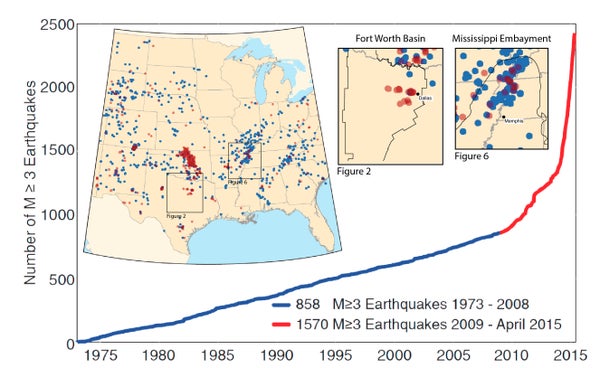Since 2008, Texas, Oklahoma, Kansas and a handful of other states have experienced unprecedented surges of earthquakes. Oklahoma’s rate increased from one or two per year to more than 800. Texas has seen a sixfold spike. Most have been small, but Oklahoma has seen several damaging quakes stronger than magnitude 5. While most scientists agree that the surge has been triggered by the injection of wastewater from oil and gas production into deep wells, some have suggested these quakes are natural, arising from faults in the crust that move on their own every so often. Now researchers have traced 450 million years of fault history in the Dallas-Fort Worth area and learned these faults almost never move. “There hasn’t been activity along these faults for 300 million years,” says Beatrice Magnani, a seismologist at Southern Methodist University in Dallas and lead author of a paper describing the research, published today in Science Advances. “Geologically, we usually define these faults as dead.”
Magnani and her colleagues argue that these faults would not have produced the recent earthquakes if not for wastewater injection. Pressure from these injections propagates underground and can disturb weak faults. The work is another piece of evidence implicating drilling in the quakes, yet the Texas government has not officially accepted the link to one of its most lucrative industries.
Magnani and her colleagues studied the Texas faults using images of the subsurface similar to ultrasound scans. Known as seismic reflection data, the images are created by equipment that generates sound waves and records the speeds at which the waves bounce off faults and different rock layers deep within the ground. Faults that have produced earthquakes look like vertical cracks in a brick wall, where one side of the wall has sunk down a few inches so the rows of bricks no longer line up. Scientists know the age of each rock layer—each row of bricks--based on previous studies that have used a variety of dating techniques.
On supporting science journalism
If you're enjoying this article, consider supporting our award-winning journalism by subscribing. By purchasing a subscription you are helping to ensure the future of impactful stories about the discoveries and ideas shaping our world today.
The seismologists compared images of faults in north Texas with images of other faults that have been active throughout geologic history. These active cracks are in the New Madrid Seismic Zone that encompasses parts of Missouri, Arkansas, Kentucky and Tennessee along the Mississippi River. New Madrid-area faults produced earthquakes as large as 7 or 8-magnitude in the early 1800s and have produced smaller quakes since then.
When Magnani and her colleagues examined the New Madrid faults, they saw evidence of earthquakes—the horizontal rows of bricks were offset at the fault line--from the distant past into the present. But images of the north Texas faults showed zero disturbances in the last 300 million years.
The scientists then took another step to refine their results. Their seismic reflection data cannot pick up vertical offsets smaller than 15 meters, or about 49 feet. Yet the recent north Texas earthquakes were so small they caused offsets of just a fraction of a centimeter. The seismologists wanted to be sure these faults had not been producing this kind of tiny earthquake all along. They were able to do this because the offsets representing rock moved by quakes are cumulative: each new quake adds more distance. The researchers took the 300-million-year time span and calculated the maximum number of small to medium sized quakes it would take to produce a cumulative offset just shy of 15 meters. That fell into the range of 3,800 to 6,000 earthquakes – or, roughly, an earthquake every 50,000 to 79,000 years. Even if temblors occurred that frequently, the probability of a natural earthquake sequence occurring in north Texas in the previous 10 years was only one in 6,000 and the probability of two sequences was one in 60 million. Since north Texas has had five earthquake sequences during that 10-year span, the scientists write that it is “exceedingly unlikely” that the recent quakes were natural.
Mark Zoback, an expert on induced seismicity at Stanford University, says he agrees with the paper’s conclusions that the recent Texas quakes are likely tied to oil and gas production. But he would not describe the faults as completely dormant. A fault that produces earthquakes every 60,000 years is still an active fault, just one that ruptures very rarely, Zoback says. He also notes that the energy released in an induced earthquake comes from the earth – the result of tectonic stresses building up at the fault over geologic time – and not from the wastewater injections themselves. “The injections can’t put energy into the ground,” said Zoback. “The energy has to be there already and the injection just triggers its release.”
